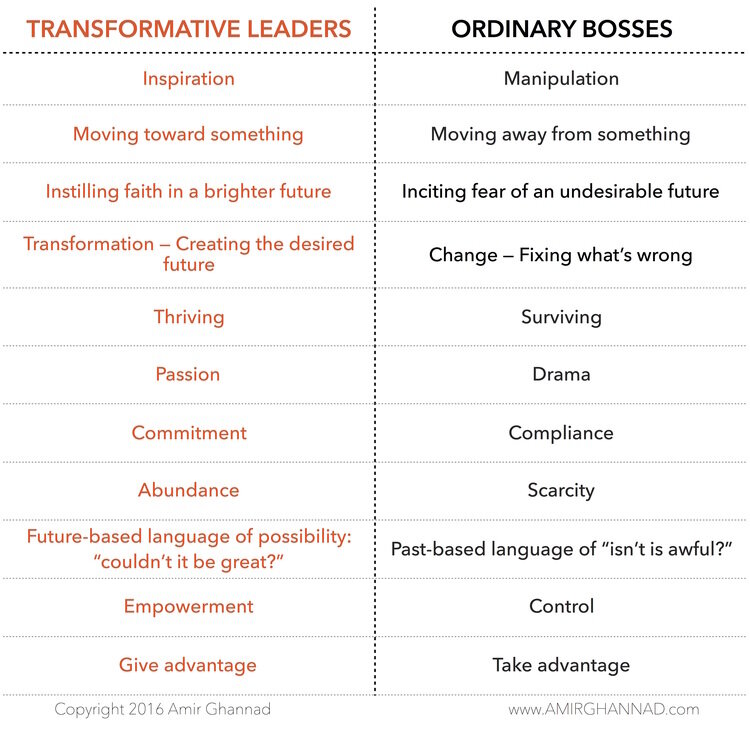The Alluring Illusion of Fear-Based Leadership!
If you'd prefer to skip to The Bottom Line, please scroll all the way down. Otherwise, I hope you enjoy the entire post.
Let’s face it. Fear mongering works! At least on some level. That’s why some so-called leaders resort to it. They attract followers by convincing people that the sky is falling and things are going to go from bad to worse unless everyone else follows their lead. As much as you and I don’t want to believe it, a great number of people do respond to tactics like this. In fact, even those of us who “know better” and consider ourselves immune to overt forms of fear mongering are subject to acting out of fear in more subtle ways. We often do so under the pretext that we know the “truth” and we look down on those who don’t subscribe to it. Some of us buy products and services because we have been convinced that without them, we wouldn’t be safe or secure. Others of us vote for political candidates who scare us into thinking that unless they are elected, the world will be a completely miserable and dangerous place. Sometimes we even abandon pretext entirely and resign ourselves, albeit brazenly and proudly, to only looking out for “numero uno.” We might compromise our values and principles in the workplace for the fear that we would lose our job if we refused to fall in line, or we give in to the petty fear of ridicule and failure instead of taking a chance trying something new. The most granular result of fear mongering is a scarcity mentality and the attitude that “I need to make sure I get mine and I don’t care about anybody else.” I don’t know about you, but that doesn’t sound very inspiring or interdependent to me.
We may not all be able to relate to all of these examples, but, consciously or subconsciously, we have all fallen into certain ways of thinking and acting simply because somebody, at some point, was able to instill a sufficient amount of fear in us. The reason for the pervasive and powerful effect of fear on all of us is simple: this is what fear is designed to do. Fear is natural–even animals we consider unintelligent have it—because, for most of our history, fear was the one emotion that consistently kept us alive. Fear is the lowest common denominator of motivation; it is designed to evoke a visceral reaction—before we can think—in response to anything we assume puts our survival in danger. That reaction, by the way, was to run as far and fast in the opposite direction, and only then start figuring things out once we had settled down. Therein lies fear’s fatal flaw as a motivation, i.e. it can’t only take you away from things, never toward things. Additionally, the very reason that fear is such a powerful motivator makes it an equally powerful immobilizer. Namely, once you aren’t in fear of danger, you aren’t motivated to do much else, lest you risk danger again.
Fear worked well back then, back when all we could be assured of was that life would be "nasty, brutish, and short"; in fact, it worked so well back then that it often works now even when there is nothing there in reality at all. Survival was so important that fear was designed to deliver false positives “just in case; this is why we are afraid of ropes in the grass and things that go bump in the night. And, just as in the past, that we had “nothing to fear but fear itself” is something that we all too often only realize in regret once we have the opportunity to sit down and look at our actions in retrospect.
Ordinary bosses capitalize on this phenomenon to their advantage—and to their ultimate detriment. Whether out of ignorance or arrogance, they fail to see that fear is inherently self-limiting and can only take an organization so far before it inevitably begins to take them in the opposite direction. Transformative Leaders don’t buy into the short term advantages of inciting fear; as tempting as it may be, they understand that whatever fruit it would bear ultimately come from tainted roots. Instead, Transformative Leaders opt to inspire faith in a brighter future among those who look to them for guidance. That is not to say that they shy away from acknowledging what is wrong and spelling out the negative consequences of inaction; but rather than framing these within a context of fear and impotence and danger, they frame these concerns in the context of what we can do now, our powerful ability to bring about transformation, and the opportunities we have to work toward something in the future. In fact, precisely because they are not seduced by the false certainty/safety offered by fear and its mongering, Transformative Leaders are straight about confronting reality and acknowledging the potential dangers ahead and are therefore best positioned to face them head-on to find workable solutions. They acknowledge fear and its power, but they don’t rely on it as a strategy to attract followers. Instead, they immediately get in action to implement solutions to mitigate actual, realistic risks and create a brighter future, and they consequently inspire others who are interested in being part of the solution. Fear, and those who peddle it, only attract those who are interested in running away from the problem, while faith, and those who understand it, create followers who are committed to moving toward the solution.
The culture of any organization or society that succumbs to fear mongering becomes one of a desperate struggle to survive—often amidst overflowing abundance, no less—and avoid negative consequences, sometimes real but most often imagined. You can hear it in their past-based language, whether they are brooding over past mistakes that can never be changed or wistfully looking back through rose-colored glasses to the “good ol’ days” that most likely never existed to begin with. Ordinary bosses are egotistical and heavy-handed, lest they lose control of the power of fear they are attempting to exploit. It is all about them when everything is going great, but when it comes to problems, it is always someone else’s fault and responsibility because they are not “The One.” Because fear only motivates when there is a perceived threat, constant fear is needed to maintain it and this is usually expressed in a scarcity mentality. You can see the manifestation of this scarcity mentality where everyone plays a zero sum game, as if there is only so much to go around and they have to put someone else down to get ahead. The struggle for survival eventually becomes self-sustaining as fear becomes even more hypersensitive, so that, whereas before there may have been legitimate issues that presented a mild threat to the organization, now new threats are conjured up where none previously existed at all. Inevitably, fear mongering leads to the outcome of the organization being further subdivided amongst itself until fear has fractured it into what are essentially silos of one. At this point, teamwork is nonexistent because there is no “team,” there is only the bare minimum of productivity, much less ability to compete with other organizations, and all but the most loyal followers have turned against the very leader that sought to use fear to motivate/control them. In the end, fear causes the organization to regress from interdependence to toxic independence, to the detriment of all involved.
By contrast, in an organization led by Transformative Leaders and in societies where the power resides with such leaders, the feel of place is much different. To begin with, Transformative Leaders do not brandish power and authority over others to keep them in line, rather they understand that their power exists solely so that they can empower others to become leaders in their own right. In fact, if a Transformative Leader is doing his or her job right, no one will be able to point to them as being solely responsible for the success and flourishing of an organization or team. Leaders serve their followers and accept responsibility for what is not going well, choosing to focus on earning their people’s commitment rather than blaming them or browbeating them into compliance. In organizations motivated by faith in a transformation, problems and issues are acknowledged as obstacles that should, and can, be overcome, but they are not dwelt upon because eliminating them, at best, only maintains the status quo. The language that is spoken is one of possibilities, that is, it is future-oriented rather than past-focused. Instead of calling on their followers to run away from the present to retreat into the past, Transformative Leaders powerfully call their allies to run toward the boundless possibilities of the future. There is enthusiasm about creating this brighter future, not just solving today’s problems, and the possibility of doing so only grows as more people become involved. People are invited to exercise their passions to achieve the desired outcome without being overcome by the counter-productive drama that sometimes accompanies this desire. In contrast to fear driven organizations, a common commitment to a transformative vision to which anyone can contribute actually serves to increase cohesiveness and interdependence, and thus fostering increased productivity and competitiveness with other organizations. While fear multiplies and eventually backfires on those who seek to use it to control others, leading through inspiring faith causes other leaders to come into being where none previously existed.
Faith is trust in a positive outcome. Fear is faith in a negative outcome. Fear can only take you halfway at most. Once one is out of danger, fear serves no purpose, fear keeps you stuck. Fear sometimes even is afraid that there is nothing to be afraid of, and we grow so accustomed to fear that we fear its absence and so we subconsciously sabotage things to remain in crisis.
The table below shows some of the key differences between bosses who manage by fear and leaders who instill faith in a brighter future. Although it may be tempting to evaluate your boss or someone else against these criteria, I would encourage you to self-evaluate and possibly seek some feedback as to which end of the spectrum you gravitate toward in your leadership style and make deliberate choices to shift your approach in the direction of the Transformative Leader as you see fit.
THE BOTTOM LINE:
Faith is belief and action that assumes a positive outcome. Fear is merely an inverted faith in a negative outcome. While fear is natural, it is only concerned with survival and not much else. Faith, on the other hand, assumes survival and is concerned with flourishing beyond it. Regardless of how one views the morality of leading through fear mongering, the fact is, using fear as a motivation can only take one halfway to thriving at best. This is because fear is an extremely powerful motivator only as long as there is some perceived threat; once the threat is gone, fear can’t be counted on to do anything except keep you right where you are. Faith, on the other hand, is driven toward the boundless possibilities of abundance and flourishing that exist in the future, and this is inherently self-liberating; no matter how grand one’s transformative vision is, there is always the potential for it to grow as one approaches it. If we were given the choice between barely surviving and abundantly thriving, would any of us choose the former over the latter? The truth is, we make that choice every day whether we recognize it or not.
Have a great week! May you Boldly Declare, Courageously Pursue, and Abundantly Achieve the Extraordinary! As always, I would love to hear about your victories and/or challenges. Please leave your comments below or send me an email at amir@theghannadgroup.com.
Copyright © 2016 The Ghannad Group, LLC, All Rights Reserved.


